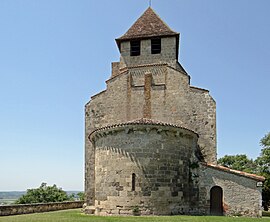
The Prix de Rome or Grand Prix de Rome was a French scholarship for arts students, initially for painters and sculptors, that was established in 1663 during the reign of Louis XIV of France. Winners were awarded a bursary that allowed them to stay in Rome for three to five years at the expense of the state. The prize was extended to architecture in 1720, music in 1803 and engraving in 1804. The prestigious award was abolished in 1968 by André Malraux, then Minister of Culture, following the May 68 riots that called for cultural change.

Count Hippolyte François Jaubert was a French politician and botanist. The standard author abbreviation Jaub. is used to indicate this person as the author when citing a botanical name.

The Livingston family of New York is a prominent family that migrated from Ireland to the Dutch Republic, and then to the Province of New York in the 17th century. Descended from the 4th Lord Livingston, its members included signers of the United States Declaration of Independence and the United States Constitution. Several members were Lords of Livingston Manor and Clermont Manor, located along the Hudson River in 18th-century eastern New York.
Saint-Cyprien is a former commune in the Lot department in south-western France. On 1 January 2018, it was merged into the new commune of Lendou-en-Quercy.
The Commission des Sciences et des Arts was a French scientific and artistic institute. Established on 16 March 1798, it consisted of 167 members, of which all but 16 joined Napoleon Bonaparte's campaign in Egypt and produced the Description de l'Égypte. More than half were engineers and technicians, including 21 mathematicians, 3 astronomers, 17 civil engineers, 13 naturalists and mining engineers, geographers, 3 gunpowder engineers, 4 architects, 8 artists, 10 mechanical artists, 1 sculptor, 15 interpreters, 10 men of letters, 22 printers in Latin, Greek and Arabic characters. Bonaparte organised his scientific 'corps' like an army, dividing its members into 5 categories and assigning to each member a military rank and a defined military role beyond his scientific function.

The Puisaye is a natural and historical region of France, now divided between the departments of Loiret, Nièvre and Yonne. Its historical and administrative center is the town of Saint-Fargeau. Its inhabitants are known as Poyaudins.

The Natural History Museum of Grenoble is a municipal museum founded in 1851, in Grenoble, France. Since the opening of the building in 1855, it presents to the public a rich natural heritage, in particular alpine heritage. The museum houses a collection of one and a half million objects and specimens in the disciplines of botany, zoology, geology and even ethnology. Facades and roofs on the edge of the Jardin des Plantes have been listed as historical monuments since January 24, 1944.
This page is based on this
Wikipedia article Text is available under the
CC BY-SA 4.0 license; additional terms may apply.
Images, videos and audio are available under their respective licenses.









